|
Monday, March 24, 2008
Progress Notes
The other day I accompanied a moving truck to the home of Janet Hix Buthold of near
Russellville to return to her a historic piano she had loaned to the museum some twenty
years ago but with the understanding it would be returned when her son was old enough to
take it. The piano, made by Guild, Church and Company (photo 01) belonged to her grandfather, Phillip Hauenstein (photo 02), who was the son of William
Hauenstein Sr., who was the original Hauenstein to arrive in this county many years ago.
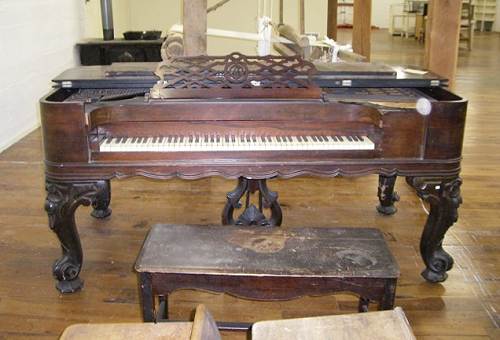
01 Piano
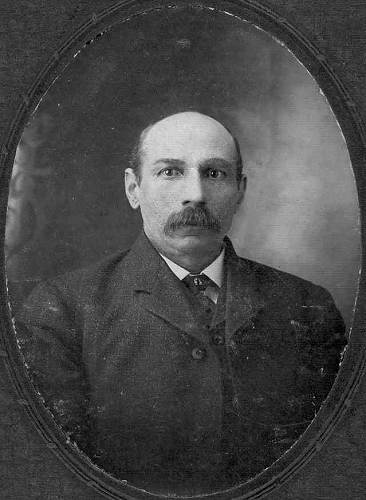
02 Phil Hauenstein
From the Hauenstein family originated Hauenstein General Store, Anchor Milling
Company, and several Osage River steamboats. Phil Hauenstein was most associated with the
management of Anchor Milling Company. He had several children, one of whom, Ida, married
Byron Hix (photo 03 of Byron and Ida),
who later became manager of the Bank of Tuscumbia.
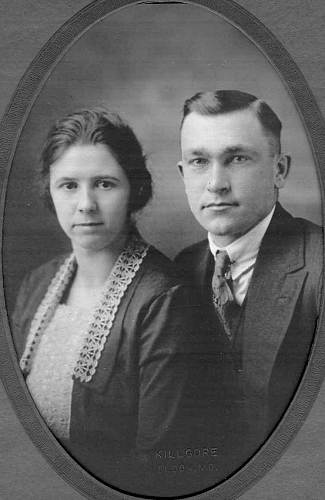
03 Ida and Byron Hix
Janet was the daughter of Ida and Byron and was raised in Tuscumbia. The piano
was probably made in the 1870's and is identical to one on display now at the Cole County
Museum. As noted in the photo above of the piano, in which you can also see evidence of
our ongoing renovation project, the piano is large and heavy. In fact, it was so difficult
to move that whenever the Osage River flooded into the first floor of the Phil Hauenstein
home (photo 04 of home) ropes were
attached to the four corners of the piano and from pulleys hooked to the ceiling the piano
was lifted up above the water level and left there until the Osage River receded.
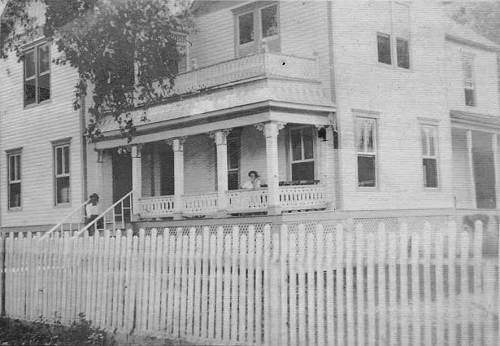
04 Phil Hauenstein Home
When Byron and Ida married in the mid 1920's, the piano was moved to their new
home on High Street (photo 05) which
was very near the courthouse. Ida was an accomplished pianist and was the pianist for the
Tuscumbia Presbyterian Church. I remember seeing the piano in her home many times growing
up as a young boy in Tuscumbia. After Ida and Byron had passed away, Janet offered on
temporary loan the historic piano to the museum where it has remained for quite a few
years. So it was with nostalgia that I saw it leave but I was happy that it was going to
stay in the possession of descendents of the Hauenstein family.
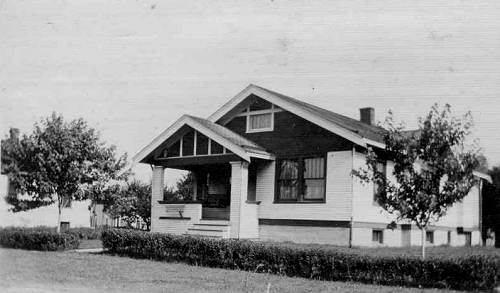
05 Byron and Ida's Home on High Street
I hadn't visited Janet in her present home before but appreciated the opportunity
to scan all the old historic photos and paraphernalia she has collected over the years
having to do with Tuscumbia and Miller County. Especially interesting to me were the many
different old photos she had of her grandfather, Phil Hauenstein, who as mentioned above,
was instrumental in establishing and managing Anchor Milling Company. One interesting item
she has kept all these years is a fur stole and hand muff which belonged to her
mother, Ida. And it was just as interesting to see the old photo of Ida wearing the fur stole and muffler which gave me the idea of photographing Janet wearing it too (photo 06 and photo 07 of Ida and Janet wearing fur piece)! This is a very old
fur piece going back to the early 1920's. I judge from the tail that
this was a raccoon.
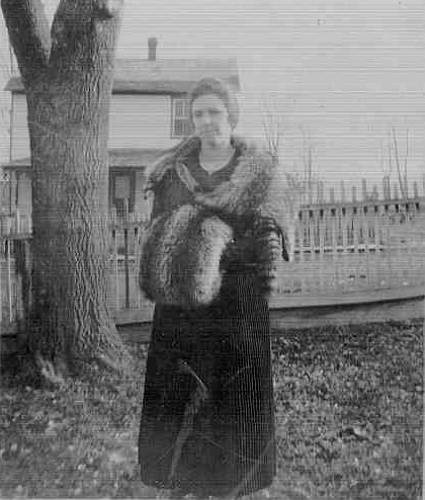
06 Ida Wearing Fur
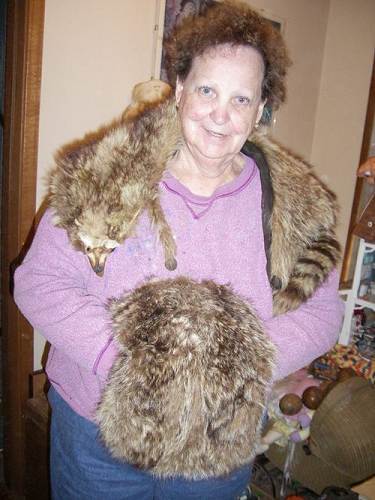
07 Janet Wearing Fur
Janet has much of the china and silverware (photo 08) which belonged to her parents and grandparents as
well as furniture pieces (photo 09).
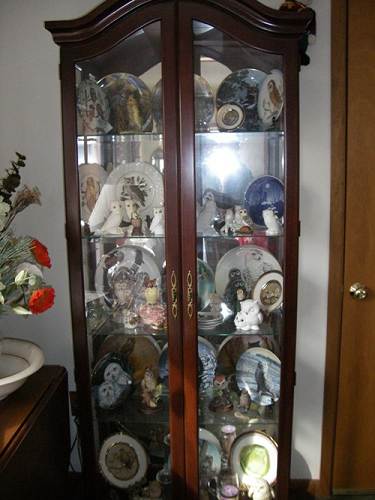
08 China Collection of Idas
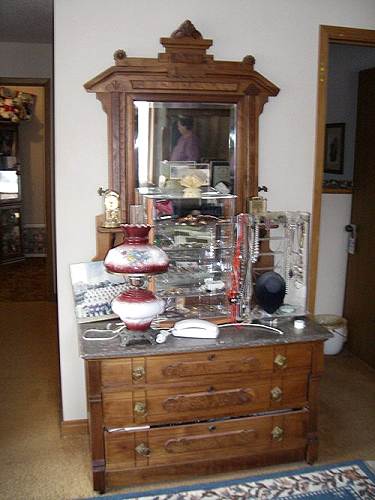
09 Ida Hauenstein Hix's Bedroom Furniture
She also has two pieces of bedroom furniture which originally were purchased by
J.R. Wells for his impressive house which he built over a hundred years ago on his large
farm along the Osage near Tuscumbia (photo 10).
Another valued possession is the old Bible kept on the lectern of the Tuscumbia
Presbyterian Church since it was started in 1889 (photo
11).
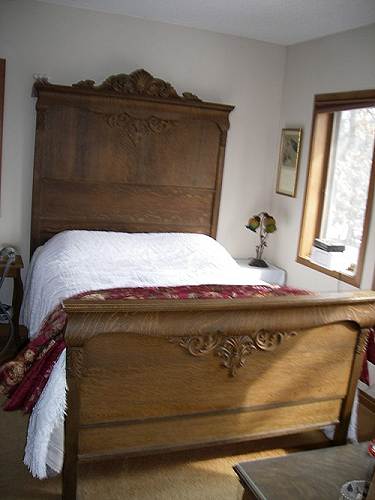
10 J.R. Wells House Bedroom Furniture
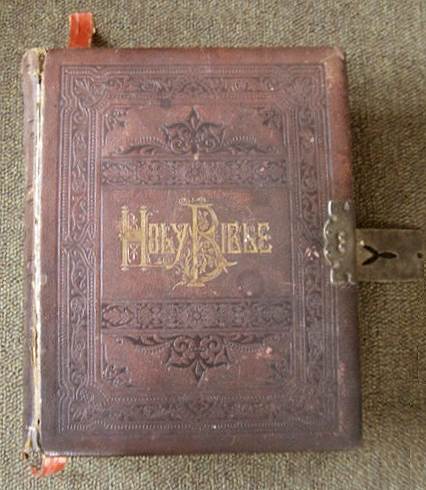
11 Presbyterian Church Bible
One interesting surprise for me was that over her adult lifetime Janet has been a
collector of hobby items having a huge number of them displayed in large windowed cabinets
throughout her home (photo 12 and photo 13 of beanies and owl collection).
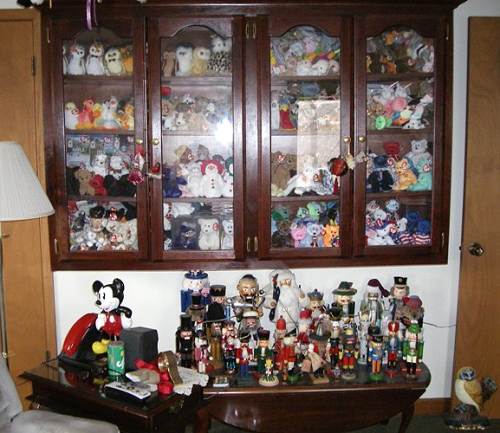
12 Beanie Baby and Figurine Collection
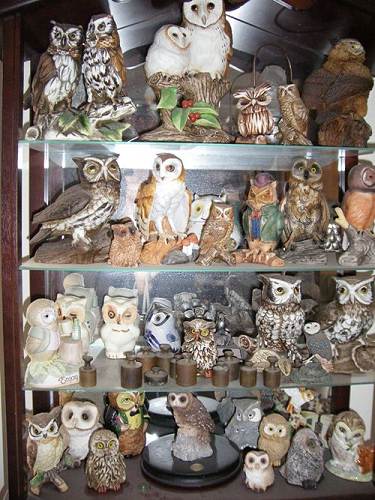
13 Owl Collection
Janet's father, Byron Hix, also was a collector of sorts as noted by his
collection of canes (photo 14) and
license plates going back to 1925 (photo 15 of
plates). Notice that every plate has the same number, "829." The
Autogram newspaper even featured his license plate collection in one of its issues which I
hope you can read since the quality of the old newsprint wasn't very good (photo 16).
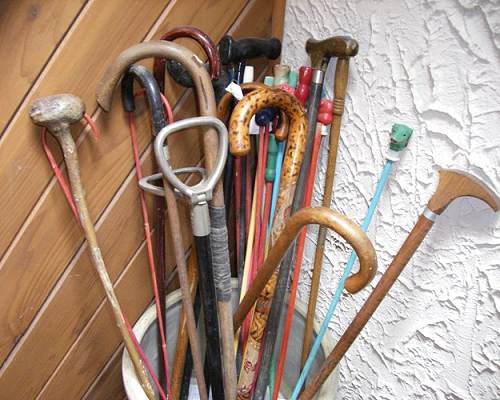
14 Cane Collection
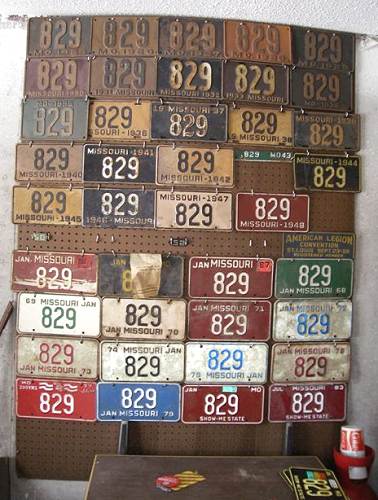
15 License Collection 829
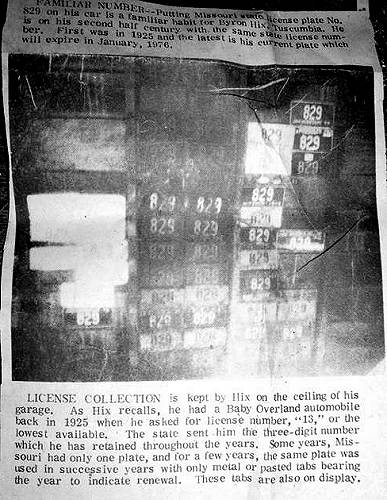
16 License Collection Article
Click image for larger view
Janet has another hobby which is painting colorful pictures. She has quite a few
of these, enough that she would like to begin selling some of them to free up some space
in her studio. Here are a couple of them (photo
17 and photo 18).
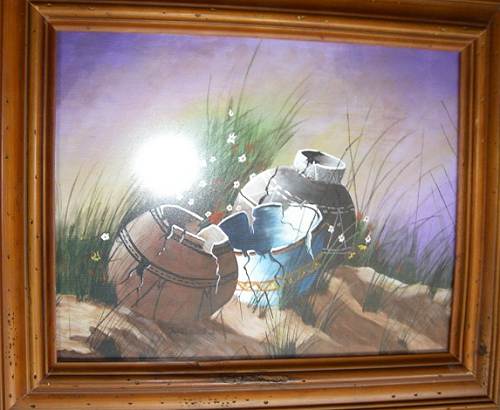
17 Indian Pottery
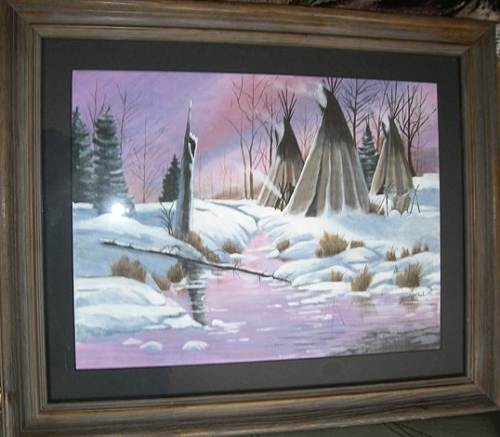
18 Indian Camp in Winter
In addition to paintings Janet has drawn a large number of sketches of Tuscumbia
and Miller County scenes and structures which at various times she has donated to our
museum for resale which contributes to our operating budget. Here is one of them (photo 19).
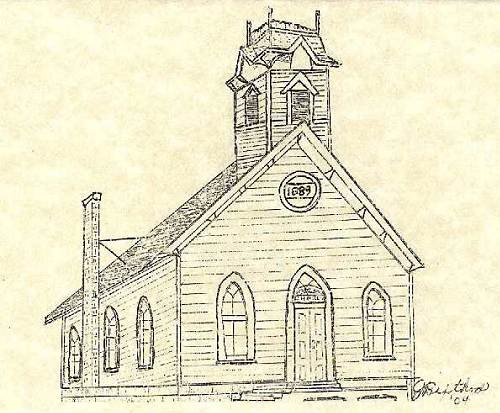
19 Old Presbyterian Church
Marvin Buthold, Janet's husband, also is a collector. While he was employed for
thirty years by Coca Cola of Jefferson City he had the opportunity to collect items Coke
gave to store owners and vendors as well as the general public. Most of these items are
old and qualify as antiques. In fact, he has one of the largest collections of Coca Cola
memorabilia in the country. Marvin has acquired so many Coca Cola items that he has had to
convert bedrooms and closets into storage areas (photo
20). This one photo doesn't do justice to any attempt to display the many areas
of the home which has old Coke Company souvenir paraphernalia collected.
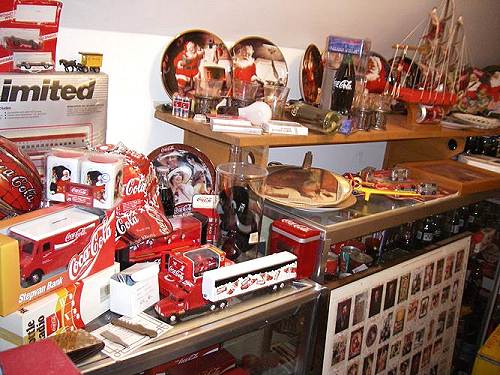
20 Coke Collection
Marvin also has a huge collection of steins as well (photo 21).
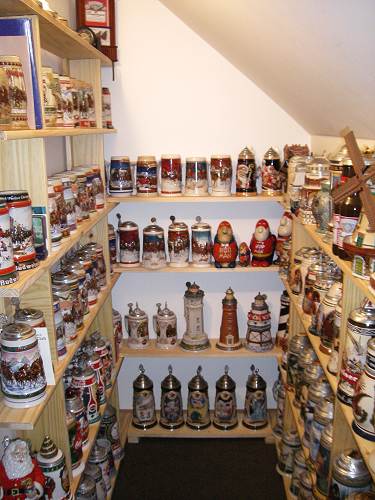
21 Stein Collection
Janet's father, Byron Hix, was from south of the river. Janet said he courted Ida
coming by horseback across the suspension bridge. After marriage, they lived for awhile
with Ida's father, Phil Hauenstein, in his large house in Goosebottom (photo 22), then moved to a new house which is still standing
on top of the big hill where the courthouse is located.
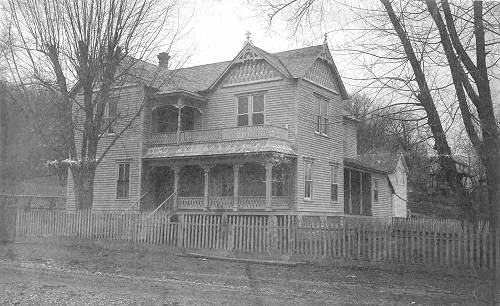
22 Phil Hauenstein House in Goosebottom
This house is where Janet was raised (see
photo 05 above). Byron spent most of his career in Tuscumbia working for the
Bank of Tuscumbia which was started by Captain Robert M. Marshall, who was discussed here
a couple of weeks ago. His work there, which he began in 1916, was interrupted when Byron
was sent overseas in WWI along with many other Miller Countians. He was involved in quite
a bit of military action.
In 1968 at the fiftieth anniversary of the signing of the armistice of that war the
Miller County Autogram interviewed Byron about his experiences during the war:
Miller County Autogram
1968
Fifty years ago next Monday, the armistice was signed. At 11 a.m.
on November 11, 1918 bugles sounded the "cease fire." This signaled the
conclusion of World War 1, the "war to end all wars," the "war to make the
world safe for democracy." Miller County sent 625 to serve in World War 1. Today, a
half century after that conflict, many residents of the county well remember those war
years. Among them are members of Miller County Barracks 1442, Veterans of World War 1,
which had a 1968 membership of 106, and is already launching its 1969 membership drive.
Thirty-four belong to its Ladies' Auxiliary. These groups meet regularly at 1:30 p.m. on
the third Sunday of each month at the courthouse annex in Tuscumbia.
Among the members of the veterans' group is Byron H. Hix of
Tuscumbia, quartermaster of the barracks, who recalls overseas action in World War 1. He
served in the Army from September 6, 1917 to March 28, 1919, being a member of Company 1,
356th Infantry, 89th Division. Company 1 was made up of 250 men, most of whom were from
Missouri and New Mexico.
Hix was on overseas duty in England and France from June, 1918, to
March, 1919. At the time, though, he didn't know the armistice had been signed. On
November 11, 1918 he was a patient in Base Hospital 58 at Rimacourt, France, one of 116 in
his company wounded on October 6 while in front line service in France. He was gassed, and
influenza developed. "Right at that moment, I didn't know or care what was going
on," he said. I don't think I knew anything about the armistice for a week or two.
His company had gone into front line service near Thiacourt in
late September.
On the night of October 4, 1918, Company 1 moved into position
near Jaulny. On the next tight the enemy began shelling the position severely, continuing
at intervals throughout the night. The shells included shrapnel, high explosive and gas
shells, the gas predominating. Hix recalled the men had kept their gas masks on all day
and all night, but took them off too soon with many of them being affected by the gas. As
a result of the enemy action, the company strength was reduced to some 20 men including
the cooks, supply and mess sergeants, and company clerk. When firing ceased at 11 a.m. on
the morning of November 11, the day the armistice was signed, the company was dug in along
the Autreville-Stenay road from where the few surviving members of the company, including
Byron, were taken to the Base Hospital in Rimacourt.
This weekend the 89th Division will have its 49th annual reunion
in Kansas City. The event will be held Friday and Saturday at the Mayfair Hotel and Hix
plans to attend. The reunion annually is held around Armistice Day…now Veteran's
Day…and draws some 250. About nine or ten are expected from Company 1 with which Hix
served.
Thanks Autogram for the 1968 visit with Byron about WWI. Here is a photo of Byron's
battle hat and post war honorary organization hats (photo 22a):
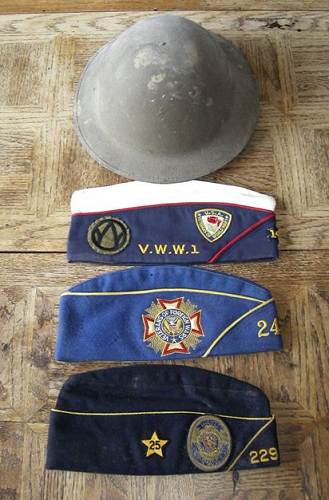
22a Battle Hat and Honorary WWI Organization Hats
Byron rejoined the Bank of Tuscumbia after the war ended having first started
working there in 1916. After fifty two years of employment at the bank, he retired in
1968. He remarked at his retirement ceremony that when he first began work, posting was
all done by hand, not electronically. Bank resources had grown in those fifty some odd
years from $150, 000 to $3,000,000 at the time of his retirement.
I had known Byron well as a young boy growing up in Tuscumbia. He attended the same
church as I did and was one of my Sunday School teachers. I remember him as always wearing
a coat and tie, rather quiet and soft spoken. He also had a very gravelly voice which
often he tried to clear. This was the result of his gas injury which injured his lungs
permanently as well as his vocal cords. But old timers remember Byron for something else:
you may remember in last week's Progress Notes that Byron's prowess as being one of Miller
County's best baseball pitchers was mentioned. He loved baseball and It was such a large
part of his early life that Janet, his daughter, has kept and preserved the baseball
uniform he wore during those days (photo 23).

23 Byron Hix Baseball Breeks, Belt and Socks
When I saw the raccoon fur that Janet's mother, Ida, used to wear it reminded me of
the days when a lot of trapping went on and when hides could be sold for a small sum back
in the days when money was scarce during the depression. And following that theme, I would
like to copy here another original essay by Elmer (Dub) Brown (photo 24) regarding his hunting and trapping days as a young
boy and especially his relationship with a local neighbor, Roy Gosney, who taught him how
to hunt, trap and how to generally get along in the woods:
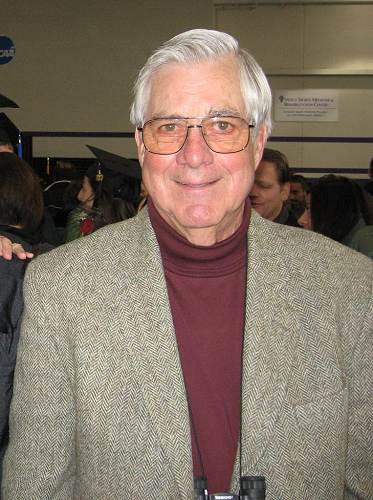
24 Elmer Brown
ROY GOSNEY
One individual who probably had as much influence on my
formative years as any was Roy Gosney.
Roy lived on a farm owned by Fred Whitlock, our mail
carrier, and took care of the cattle, fences, etc. He was in his mid fifties and though he
had six children, he and his wife were divorced so he was pretty lonely most of the time.
The three boys, Bob, Charles and Wayne spent quite a lot of time with him in the summers.
Charles and I were about the same age with Bob being two years older and Wayne being about
two years younger.
He had been in the army during WWI, serving as an
artillery teamster in France for about a year. Roy didn't talk about his experiences very
much, but once in a while after my persistent probing, he would open up a bit. I never
tired of hearing him talk about galloping forward with the gun or ammunition carrier in
tow, dropping the load and then racing the horses away before the firing started.
Roy was not an educated man, but he loved to hunt and
fish, and he loved kids. I don't know if that was the big attraction or the fact that I
was the only male in our household or a combination of both. At any rate, I spent as much
time as possible with Roy beginning at about age ten. He lived about a mile from us, and I
made numerous trips back and forth, walking, riding my bike, or driving the Model A Ford
as I got older. I wasn't able to do the latter until I got to be about fourteen. I still
didn't have my license but the chances of getting stopped were practically zero since the
highway patrol never got off onto the gravel roads.
Roy worked for us as a hired hand from time to time
building or repairing fences, haying and doing various other chores too hard for mother
and me to do. He had injured his right hand in some way and the wound had gotten blood
poisoning. This had resulted in the last two fingers being permanently curled in against
the palm. I suppose it handicapped him to some extent, but if so, I never noticed. He
could still work circles around me.
Naturally I worked with him if I wasn't in school or
otherwise occupied. I learned a lot about farming and life in general from my exposure to
him.
We spent many days and nights prowling the woods. In the
summer and fall our favorite past time was squirrel hunting. Roy always had two or three
"tree" dogs ranging from hounds to terriers. My dog, Scrapper, had also gotten
to be pretty good at finding the gray and fox squirrels common in the area. After the
inevitable fight between the dogs sorting out who was the leader, we would set off through
the woods, with them ranging ahead looking for game. Their excited barking would signal
that they had one treed, and we would proceed to where they were. Then the trick was to
spot the squirrel. The grays tend to take off running through the treetops if they can
while the reds are more likely to stay put. They are both very adept at concealing
themselves either in a bunch of leaves or by keeping the tree trunk or limb between them
and the danger. In situations where they did the latter, one of us would stand quietly on
one side of the tree while the other moved around to the opposite side and created a
racket of some sort. This would usually cause the critter to show itself and allow a shot.
If you were by yourself, of course, you had to be a bit more resourceful and throw a stick
or something into a bush or tree on the other side. Hopefully this would cause the
squirrel to think there was a danger there and move around the tree trunk.
Late fall and winter our interests turned to opossums and
raccoons, which we hunted at night. Warm nights after a cold spell are the best since the
game is more likely to be moving about and it is easier for the dogs to pick up their
scent. Again, the approach was pretty much the same as for squirrels, a leisurely walk
through the woods while we waited to hear the dogs pick up a track and hopefully bark
"treed" in a short while. There is something about listening to a good hound hot
on the trail of game, which still causes my pulse to quicken. Then, there is the feeling
of triumph when you hear them bark "treed". I can't really describe the
difference in the barks, but to this day I can easily distinguish when a hound is trailing
as compared to "treed".
If it were a possum, the trailing part usually wouldn't
last long since they don't tend to range very far and are pretty slow moving.
A coon, on the other hand, could be a different story.
They tend to cover a lot of territory and, once they know they are being chased, can move
pretty fast. Coons also tend to live around water where the hills are steeper, the
"hollers" deeper, and the brush and timber thicker. I've taken many a header
from stepping in a hole or tripping over a vine and wondered if I was ever going to land.
We never had it happen to one of our dogs, but there were
always stories about a coon taking to the water, luring the dog out over its depth and, in
the process of fighting it, climbing on its head to drown it. Don't suppose the coon could
employ this tactic very well if you had two or three good big hounds.
Once we arrived at the tree, we still had to spot the
game. Since both possums and coons are pretty good size, and since there were no leaves,
this usually wasn't too difficult. A good, bright flashlight was essential to see for a
head shot with the .22. Since we were interested in selling the pelt, we didn't want a
body shot, which would reduce the value.
Roy also taught me how to trap, and I earned a fair amount
of spending money in my last years of grade school that way. Possums and rabbits were my
most common catch, but I did get an occasional grey fox, skunk or weasel. My first skunk
did a number on me, and I certainly wasn't very welcome at school that day since I didn't
take time to change before I left. I quickly learned to take the .22 and dispatch the
critter from a safe distance so as to prevent that from happening again.
The market for everything except the rabbits was, of
course, in their pelts with a grey fox bringing about $3.00 down to about $.75 for the
possum. The rabbits we gutted and hung in the smokehouse, where it was cold, until we had
accumulated several. We then wrapped them in layers of newspaper, packaged them in a
burlap feed sack and sent through the mail to St. Louis to be sold for meat. As I recall,
we got about $.25 a piece for them. I often wondered what condition they were in when they
were finally consumed.
Somewhere along the way, Roy acquired an old car, and
though he couldn't drive, his eldest son Bob could and lived with his dad a good share of
the time. When Bob was there and the car was running, which it frequently wasn't, we had
transportation to go swimming at the Rock Hole, fishing at the river, or hunting someplace
Roy had heard about. He never needed much urging to put aside whatever farm work needed to
be done in favor of a jaunt with anywhere from one to four boys and as many dogs as we
could load aboard.
Roy was also a bee-keeper and was always on the lookout
for bee trees when we were in the woods. In early spring he would sometimes carry a little
jar of sugar water with him. He would either pour some in a lid or over a piece of rag and
then come back in the next day or so to see if any bees had found it. Where they were
working it, he would watch to see which direction they flew and then follow at a dead run,
hoping to find the hollow tree where they had their nest. The man couldn't see to read
without glasses, but he could track the flight of a bee for what seemed to me to be an
incredible distance. I could never do it.
Once he had found the tree, he would cut it down and
attempt to capture the bees. It was probably just as illegal to do then as it is today,
but it was common practice and no one thought much about it. Roy frequently asked me to
help him on these ventures, and I did a few times, but only after securing his promise
that he would use lots of smoke to stun the bees and provide me with a head net and
gloves. I had been stung a number of times, always it seemed around my eyes, and tended to
swell pretty badly. He couldn't quite understand this since a bee sting to him was no more
annoying than a mosquito bite to most people. He humored me, though, because he always
needed someone to help carry things and pull one end of the cross-cut saw.
I got into high school and became immersed in other
activities so gradually drifted away from Roy. My intentions were always to spend time
with him, but something always seemed to get in the way.
In one of those years, we had a severe storm during the
night. I suppose it was actually a small tornado, but no one knew for sure. It flattened
Roy's small house with him in it and in bed. There was no electricity yet and no way to
get a lamp or lantern going. Somehow he managed to dig himself out and make his way to a
small cave about half a mile away on the Harrison place where he spent the remainder of
the night. Why he didn't go to one of the neighbors who lived nearby I don't know.
Probably too embarrassed to do so since he was clad only in his underwear. This incident
had a traumatic effect on him, and after that, wherever he lived, he would become panicky
unless he could get to a cave or cellar whenever a storm came up.
I last saw him when I was in my freshman year in college.
By this time he was living in a small house at the edge of Eldon. I took my old dog,
Scrapper, who had been on just about all of our escapades, and went to see him. We sat and
reminisced about many of our adventures and his happiness at seeing us was heartwarming.
Scrapper was sprawled nearby, and every once in a while, he would raise his head and look
at us as if to say, "Hey, I was there, remember?"
I was somewhat ashamed of myself for having neglected a
friend who had given me so much.
Both Roy and Scrapper died not long after that.
Thanks Dub!
That's all for this week!
| 


